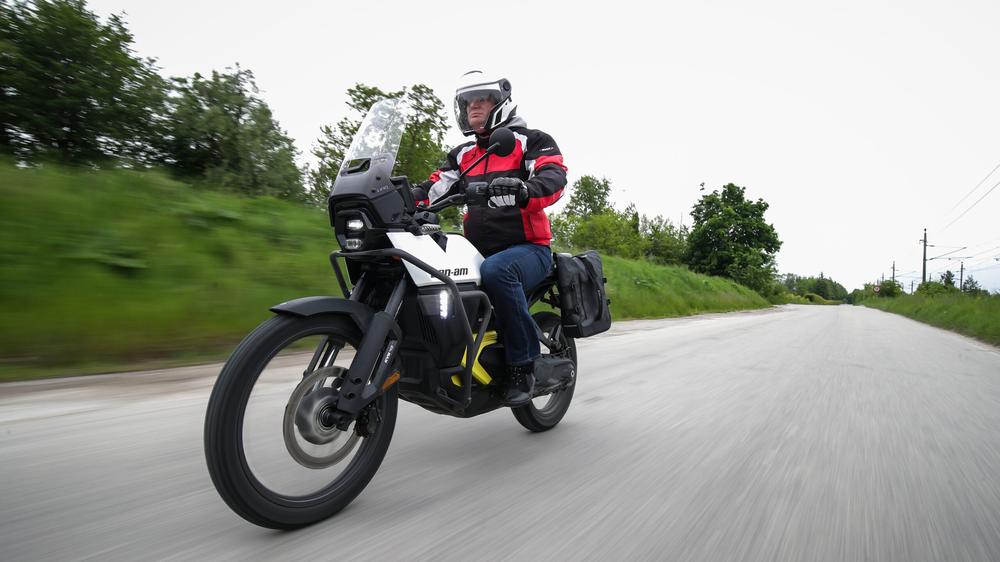"There was always a passion about motorbikes. But it's not only passion, it also needs to be a sustainable business model," Mario Gebetshuber, BRP-Rotax vice president of global sourcing and operations powertrain, told Ars Technica during a tour of the company's museum of motors over the decades.
Gebetshuber says the company wanted to return to the motorcycle market but knew that it was a highly competitive and extremely crowded market. The COVID-related motorcycle sales bump didn't last, and Rotax wasn't interested in what it anticipated would be a 5 percent market share battling against traditional companies like Kawasaki, Honda, Harley, BMW, and others. It's going electric with its bikes and something else—it's not saying what—in August.
"If we want to enter, we want to enter to be a player," Gebetshuber said. Electrification was where the company saw itself as able to move quickly. It could be Rotax's anchor and a way to jump ahead of the competition and grow.
Rotax has already introduced a Ski-Doo electric snowmobile, and the Can-Am Pulse and Origin electric motorcycles have quickly won over fans of traditional internal combustion engine-powered motorcycles. During my two times on the bikes—once in Texas in grueling heat and a second time in Austria ahead of my interview with Gebetshuber—I've watched people who review motorcycles quickly become enamored with the electric powertrain.
Make it in-house
At the heart of those Can-Am electric bikes is technology from BRP-Rotax. At its facility in Gunskirchen, Austria, Rotax designs, develops, and builds its family of internal combustion engines. These engines have not only ended up in BRP-Rotax machines but also in bikes from BMW, Aprilia, and others. Within that same facility, the company decided to go electric. It started with a snowmobile, took a weird turn with extremely fun electric karts (that you can't buy, but more on that later), and most recently ended up in the bikes that resurrected the Can-Am name. But Rotax isn't done. This August, a third consumer adventure vehicle will be outfitted with its electric REV Gen5 platform.
Whether I was riding in the rain in Austria or the blazing heat of the Texas sun (115° F/46° C), Rotax's focus on thermal management kept the two Can-Am bikes ready to deliver the expected power at any speed. It's not only a tremendous feat of engineering, but on the road, it can mean the difference between life and death.
Motorcycle riders are keenly aware—because we are routinely reminded—that our method of transportation is inherently dangerous. We straddle a motor connected to two wheels with a metal frame holding it all together. While astride these machines, it's important that everything works as expected. More so than inside a car, counting on the brakes and powertrain to perform as anticipated is extremely important. Thermal fade in a car isn't great. Thermal fade in a motorcycle could lead to a life-threatening situation.
For a company that has been building motors for itself and other bike makers, the importance of creating a vehicle that performs as expected is likely not lost on Rotax.
The company is also aware that the rest of the motorcycle industry is likely keeping an eye of the Can-Am bike sales. "They know what we did in the power sports industry, that we are a serious company with design, development, manufacturing capabilities, an international footprint, an international global supply base, and we have the knowledge to do great products. If I [were] them, I would be watching us," Gebetshuber said.
Like other businesses, Rotax is trying to deal with the fallout of the United States' chaotic tariff situation. Gebetshuber notes that the company doesn't want to comment on politics but, "what we can say is the environment is currently very difficult, because changes are happening faster than we're able to react."
It does help with development that nearly everything is done in-house. The motors are built at a Rotax facility. The bikes are put together at another. Development is done in Austria. Nearly everything on the Can-Am bikes is either built by Rotax or, in the case of the inverter on the electric platform, built to Rotax specifications.
It's a system that requires additional initial resources during development but gives the company tighter control over the finished product. It also has the potential to bring down costs in the long term. Just ask Rivian. The electric truck and SUV startup reengineered its second-generation vehicles and was able to reduce costs and speed up production.
What’s next?
That development is likely already underway for Rotax's next electric vehicle. It's fun to speculate, but a Can-Am side-by-side or quad with an electric powertrain sounds ideal. Something from Sea-Doo doesn't make much sense. Not just because of the whole water aspect, but the lack of infrastructure on bodies of water. This would be the third electric consumer product.
There's also the fourth product. The electric karts at the Rotax Max Dome in Linz, Austria. Rotax has a long history of gas-powered karts. The electric karts, built on the same platform as the motorcycles and snowmobile, are a great way to bring the fun of karting inside while demonstrating the power of an electric architecture.
I'm also happy to announce that I placed first in my race against other motorcycle journalists and some Rotax employees. It was great fun, which is sort of the reason behind all of what Rotax does on land, sea, and snow with its adventure vehicles: deliver fun.
The move to electrification from a company with over 100 years of gas-powered experience doesn't squelch the joy of those vehicles. In some cases, it actually enhances the experience. Rotax isn't going into any of this lightly and is certainly not phoning it in. It's looking at the market and determining where it can succeed as the world transitions to cleaner transportation alternatives. Even ones that can do wheelies.

 Big banks fund climate chaos—here’s how to switch
Big banks fund climate chaos—here’s how to switch